Favourite Flies for the River Clyde (continued)
THE LOOPWING
| The materials needed for the wings are
six fibres from a mallard flank or shoulder feather, and they must be long
enough to form both
tails and wings. As small dry flies are the main object of this loop wing method of tying, this does not present much of a problem. These
fibres are tied on top of the hook shank at the position where wings are
normally fixed (fig 1). The front part is now doubled over to form the wing, and
its length can easily be regulated by using a dubbing needle as a "controller".
The length having been decided, the doubled section is now tied down (fig 3) and
fixed in the upright position with turns of silk close up to its front (fig 4).
The wing is now divided exactly in half, also with the help of the dubbing
needle (fig 5) and the two sections thus formed are kept permanently separated
with one figure-of-eight turn between them. The tying silk is now taken back to
the tail end of the hook, the body added (in this instance a dubbed fur one) and
taken up almost to the wings (fig 6). At this stage the hackle is added, being
tied in with turns of the silk and body, which is then continued in front of the
wings, and the fly finished off in the usual manner. The complete effort should
appear as in fig 8. It is an exercise in tying and material economy which is
both simple and successful. |
|
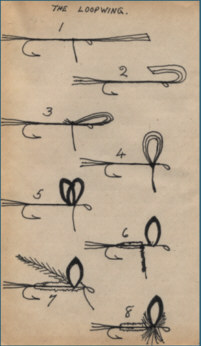 |
RUSSELL'S GRANNOM
| Russell's Grannom is tied on a size 14
hook and has a body of Heron herl with a green d.f. wool tip. The wing consists
of a bunch of blue dun cock hackle fibres clipped level with the hook bend. The
head hackle is ginger cock. The tying silk is green. This fly is an excellent
floater, although it also kills at times fished sunk. It has accounted for a
great many trout. |
|
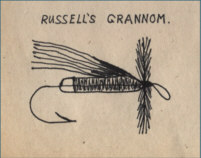 |
GOLDIE
|
Hook:
Size 16
Tail:
Red Wool
Body:
Fine gold wire, flat gold tinsel.
Hackle:
Dark ginger cock
Tie in a small piece of red wool for
the tail. Then tie in a piece of fine gold wire, which will be used later for
ribbing the flat gold tinsel body and tying down the palmer style hackle. Wind
on the flat gold tinsel for the body and tie in a dark ginger cock hackle and
wind this down the hook stem towards the tail - over the top of the flat gold
tinsel in a sort of ribbing fashion. Now bring the ribbing wire over the end tip
of the hackle and fix it down at the tail. Snip off the tip of the hackle and
start ribbing the body and the body hackle with the ribbing wire.
|
|
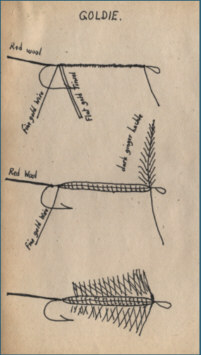 |
THREE CLYDE FLIES
CRAN SWALLOW
|
Although this pattern is probably one of
the best known of the Clyde flies, its popularity is by no means confined to
that river. It is popularly regarded as a late summer pattern and is a sound fly
to have on the cast from then until the end of the trout season. It is normally
fished on the tail or as a first dropper in size 14 or 16. It should be dressed
sparsely, with a minimum of materials, and the wing should be set down flat over
the back of the body. Start off the dressing by winding on the
body, which is of yellow tying silk. Some Clyde fishers opt for a short flat
gold tag at the end of the yellow body, but when the Cran Swallow is taking
fish, the tag does not seem to matter. The wing consists of strips of the
secondary wing feather of the swift, rolled over so that the light side of the
feather is outermost, and tied down flat. For the hackle, which needs only one
turn at the most, you should use a bronzy breast feather from a starling, tied
in and wound on after the wing has been put on.
|
|
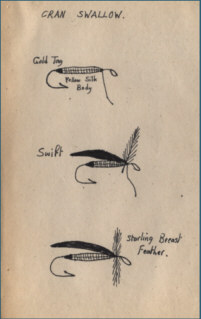 |
Tail:
None
Body:
Waxed primrose tying silk
Wings:
From secondary wing feather of the cran swallow, otherwise the
swift, light side out and tied flat along the hook shank. A good substitute is a
starling wing dyed faintly blue dun.
Hackle:
A bronze tinted body feather from the starling, one turn only.
BLUE UPRIGHT
Tail:
Two or three blue dun hackle fibres
Body:
Stripped quill from peacock eye feather showing distinct
markings.
Wings:
Smokey blue from secondary wing feather of snipe or fieldfare,
light side out and set upright.
Hackle:
Smokey blue, otherwise blue dun, one turn behind wings.
HEN BLACKIE
|
Tail:
None
Body:
Waxed primrose tying silk
Wings:
From secondary wing feather of hen blackbird, light side out and
tied flat along the hook shank
Hackle:
Black hen, one turn only
|
|
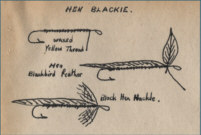 |
Next page
|